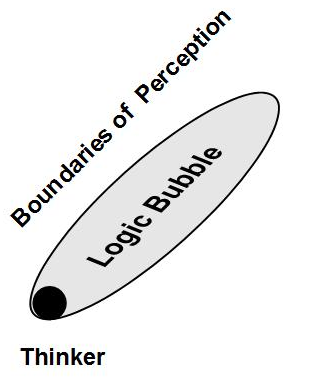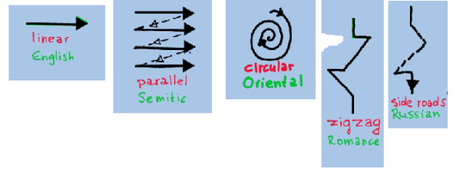
Daily Thinking – the thinking you do quiet effortless during the day – do have some features. In this blog we will point out some of the characteristics of Daily Thinking that differs from scientific or deliberate thinking. However, that does not mean in our opinion that Daily Thinking habits does not effect or have effected academic thinking, as for instance in economics, psychology, biology and medicine
Daily Thinking takes place, as deliberate thinking does, in a logic bubble
The most dominant feature of Daily Thinking is that it happens in a logic bubble, and that no conscious effort is made to escape from that. The logic bubble – or the standard thinking pattern – is the thinking space that defines the width and depth of the thinking, its time frame, what is Left Out and what biases color the construction of reality. Daily Thinking is fierce controlled by social influences and the Main Stream Media.

Neglect of the importance of focus
In Daily Thinking thinking happens automatically without any reflection on what exactly the subject is and what to obtain with the thinking. There is an absence of meta thinking. As a result Daily Thinking is reactive.

There is also a tendency to focus on immediate problems, neglecting long term challenges. Also, we habitually prefer solutions that focus on fighting results (“putting out the fire”) instead of preventing and detecting the cause (fire detectors and prevention plans). Mostly, rules follow from crises, instead of the other way around. If thinking about risks we tend to think that the worst thing that can happen has already been in the past, not in the future.
If there is an effect, then it has a cause
In Daily Thinking we suppose -without further thinking – that an effect has a cause, which is not always so. Or the effect could be merely coincidental with the cause, or the effect could be produced by a complete other cause or it could be happen that two causes produce together an effect.

There is a linear relation between a cause and an effect
We are inclined to assume that the relation between a cause and an effect is a linear one, but it could be exponential, or a flattening relation (the influence of the cause decreases in the course of time..

The relation between a cause and an effect could also been shaped by a bell curve, also called a life cycle curve.

In close relation with this phenomenon is that when thinking about effects, mostly only the nearby-in-time effect is taken into account. Effects on a longer time scale are neglected.
We tend to see only purposeful effects, and not unintended side effects of causes. Also, we assume that circumstances will not change during an effect is evolving under influence of a cause.
Logic is logic, isn’t it?
Then it is assumed that the logic any person uses is the same for all humans. In other words: Chinese, Arabs, Jewish and Americans take the same thinking paths to get to a conclusion. It is supposed to be hard wired in the brain.
However, we know that thinking is narrowly related to language. And regarding the fact that Chinese, Arabs, Jewish and Americans differ in language, in the construction of sentences, in fonts and in the direction of reading/writing we might challenge that.

We suppose that those properties of language involve other brain areas and as such influences the “logic” of the thinking, although the same conclusion is been reached.

Mechanistic reasoning
However, the most remarkable feature of Daily Thinking is it mechanic nature. In Daily Thinking seldom is taken into account that there might be a feedback effect. Or in other words: a cause produces an effect, what will in turn effect the cause.

Our Daily Thinking habits are far remote from thinking in system dynamics, complex networks or system theory. However these thinking strategies originates back to 1950-1960, we still continue thinking “Newtonian” in our daily practice.
PhotoÖ “Student Thinking With Textbook” by imagerymajestic
